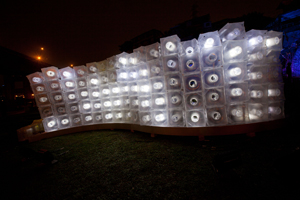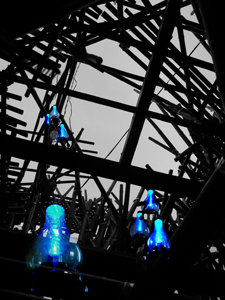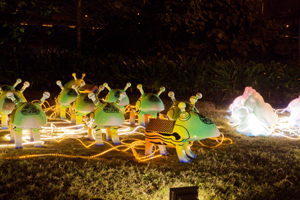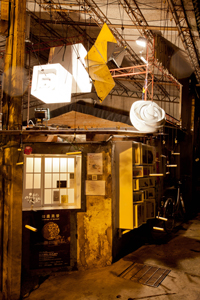Nostalgic lantern festival held in the maze of Treasure Hill
By Gloria Cho Treasure Hill is named after the Buddhist temple of the same name in the community. It was built 300 years ago and it did not constitute a real community until soldiers, who retreated with the Kuomintang government to Taiwan in 1949, came and built their homes along the hillside. The uniqueness of the space makes itself an ideal location for celebrating the conventional Chinese Lantern Festival that at the same time delves into the core of nostalgia and modernity. Planned under the theme of, "Landscape of Spectacle," that is derived from, "the theory of the picturesque," an English painting concept in the eighteenth century, the exhibition attempts to unveil the ambiguity of modern society through the conventional festive occasion. As the concept lauds nostalgic, sentimental scenes, which stirs emotions, it enables viewers to transcend the usual aesthetic experiences of "beauty" to the perception of the "sublime" from multiple angles. And to a certain degree, a "festival" lends us to see a glimpse of our city's past that "we" once built. Treasure Hill's rich historical texture and spatial composition forms clues we can use to decipher the city. In other words, Treasure Hill is like a zigzag path in the city, giving out various effects with its spectacles. The "Festival" turns this place into a memorial hall, a piece of artwork, which we might rediscover a spectacle within humanity. From now until April 21, several lantern art installations set up under the aforementioned concept are in display, awaiting visitors' exploration. On the entrance of THAV crawls a herd of recycled lamps in a form simulating human behaviors. It's a work presented jointly by Lin Chien-yu, Lin Wei-yu, Su Chia-hsien, Huang Fa-cheng, and Liao Pei-yi, called, "Out in Force Roaming." As the artists attempt to capture imagination instead of reality, the roaming monsters serve as a fairy tale-like metaphor. Inevitably, such analogy turns out a narration, a response to real-life environment. Meanwhile, the codependent relationship between the installation and the site lends visitors retrospectives thoughts of the living memories of Treasure Hill. The imaginary species are the outcome of rapid technological change, chemical development, and experimental hybridization of life forms. Through the eerie-aired tableau, Hsu's work directly involves in moral criticism of technological progress. On the Historical Facades site there are two pieces of artwork: LuxuryLogico's "The Solar," and Uno Lai's "The Light Dam". "The Solar" congregates more than 200 wasted lamps, incorporating elements of sound and customized design to yield sunshine glow effects. According to the creation team, the installation is an attempt to elaborate on, "the twin relationship between humankind and post-technological civilization using an objective model." "For this reason it serves as a theory of relativity between consumption and environment, value and quality, fables of the end times and insentience," the artists note in their statement. Uno Lai's work, "The Light Dam," made of recyclable PVC, metal, IR sensors, a solar panel, hi power LED, and an intelligent control system, aims to convey the idea that light is seeable, touchable, and it is possible to collect manmade light sources. This artwork employs a mechanism that directs an artificial light source to the solar panels and recycles part of the light rays to generate electricity. In his idea, Lai wishes not only to echo the issue of energy saving, but also to tackle the problem of light spillage and lighting pollution from a broader perspective. Wang Ming-hsia's installation, "Light‧Reading," which employs text, acrylic, and lamp elements, is a poem created for Treasure Hill, dedicated to both the landscape and the light on the site. The text of the poem is wrapped in penetrating acrylic boxes, which allows for different interpretations under daylight or evening lighting. Under daylight, the poems carry primitive meaning, while at night, the leaping lights from the tubes fragment the text and thus the message contained is reconstructed. As reality and fabrication overlap consequently, the work changes dynamically. Such diversity, in Wang's opinion, also implies the, "shifting manifestations of Treasure Hill." On the roof of the Triangular Reception hung several geometric shaped puppets, which can be manipulated by visitors. This organic installation is Liang Mong-han's, Another light installation is Lo Shao-huei's, "Sunspot: Cosmic Garden." Lo derived the inspiration for his work from Borges's novel The Garden of Forking Paths to transform Treasure Hill into a space that stretches out infinitely. Beyond mankind's perspectives, artist Weng Wei-hsiang's, "Dormant Volcano," applies a more remote beholding angle--from the outer space. The artist explains that Treasure Hill seems hidden inside a grand metropolis, but when the settlement illuminates at night, its state of existence emerges and becomes clear. A younger perspective is also shown in this exhibition. CBMI's, "Desire in Extremis" uses electrical devices, fluorescent, and neon lights in attempt to convey the younger Taiwanese generations' plight, they face of facing loss of faith, lack of imagination, narrow of values, and desires. The work integrates material from traditional lanterns and new laser-cutting technology, weaving the bamboo strips to form pavilions of bamboo. Underneath the installation is a leisure space for visitors, artists in residence, and community residents. For the time being, THAV's operations is based in the three major projects - 'Hometown preservation and revitalization,' 'Artist-in-Residence program,' and 'Youth Hostel.' Some empty houses will be used to build hostels, bookstores and studios. A total of 17 studios, 2 rehearsal studios and 3 exhibition spaces are available for the resident artists. As many of the 22 out of 100 or so former households that have stayed and continued their lives here are elders, the Tsuei Ma Ma Foundation for Housing and Community Service is established to better take care of them. "Every afternoon, the staff pays a visit to seniors to provide real time help," points out a THAV staff. With its unique location and operational methods, THAV stands out among the three art villages currently active in Taipei, namely, THAV, Taipei Artist Village and Grass Mountain Artist Village. Guides are available Tuesday to Friday at 7p.m. and 8p.m. Please call 02-33937377 ext.107 to make a reservation or visit www.artistvillage.org. (寶藏巖國際藝術村)
Staff WriterLiving in art is probably a dream for many, but it is the reality for the residents in the Treasure Hill community in Taipei. Now transformed into the Treasure Hill Art Village (THAV), the community is located in bustling Gongguan District, occupying an area less than 4 hectares and topping out at a height of 80 meters.
 Similarly applying the concept, artist Hsu Tang-wei has turned the bicycle lane into "The Extradimensional Garden," in which roaming orderly a number of imaginary creatures made of fiberglass and are coating-finished.
Similarly applying the concept, artist Hsu Tang-wei has turned the bicycle lane into "The Extradimensional Garden," in which roaming orderly a number of imaginary creatures made of fiberglass and are coating-finished.  As the artist casts his attention to the overuse and spillage of light rays, a question rises in his mind—is it possible to store light like we build dams to store water or to recycle and reuse it?
As the artist casts his attention to the overuse and spillage of light rays, a question rises in his mind—is it possible to store light like we build dams to store water or to recycle and reuse it?
"Manipulative! Organic or Geometric?" Made of polystyrene, vellum, gauze, and metal, the installation can be either geometric or organic depending on the observer's point of view.  "A city under the curtain of night is a mysterious theater, where people gather to act out," says the artist. He continues on to say that, "every time we visit where we've already been, we stumble upon the cosmic garden again."
"A city under the curtain of night is a mysterious theater, where people gather to act out," says the artist. He continues on to say that, "every time we visit where we've already been, we stumble upon the cosmic garden again."
MisoSoupDesign's, "Light-Scape," is made of bamboo and acrylic, and it aims to create a visual point at a high elevation on Treasure Hill, which blends into the settlement to become a part of the landscape.  Artist Chen Jian-zhih also employs bamboo, together with objects, light, and sound to create an installation called, "Whisper on Treasure Hill," and it is located in the Heart Chamber Plaza. The art focuses on inhabitants and their lives, drawing memories, words, and occurrences that continuously overlap in the past and present that congregates into the reality of life at the moment.
Artist Chen Jian-zhih also employs bamboo, together with objects, light, and sound to create an installation called, "Whisper on Treasure Hill," and it is located in the Heart Chamber Plaza. The art focuses on inhabitants and their lives, drawing memories, words, and occurrences that continuously overlap in the past and present that congregates into the reality of life at the moment.

![Taiwan.gov.tw [ open a new window]](/images/egov.png)
